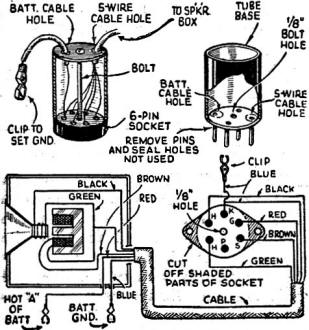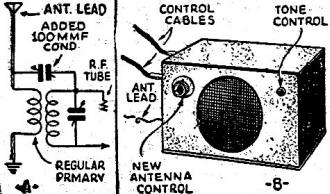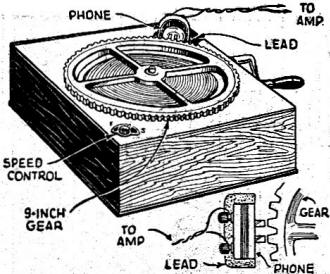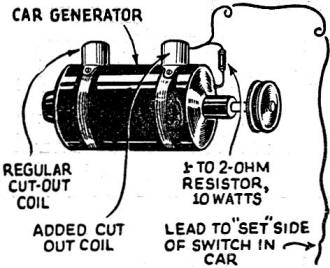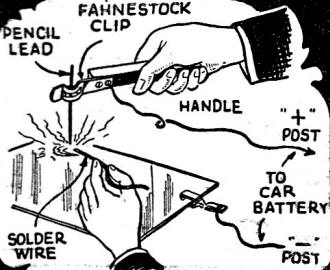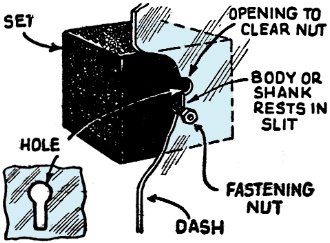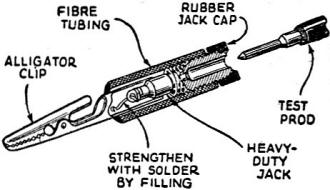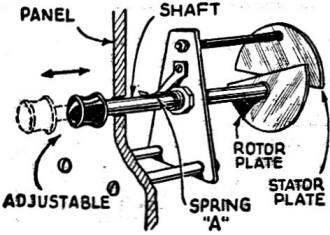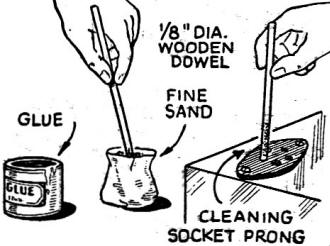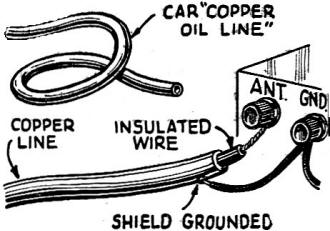Short-Cuts in Radio
|
|
It is hard to believe in 1936, a time when cars were huge and dashboards had almost nothing behind them except some heater ducts, that access to something as simple as a radio speaker would be difficult. Evidently it could be, according to the first-place winner of "Short-Cut" in Radio-Craft magazine. There was not then the rat's nest of wires, air bags, and control cables found in modern autos. Voluminous trunks back in the day, and engine compartments that you could almost stand in while changing spark plugs (I once had a 6-cylinder, 1970 Chevy truck that I could do that in) were typical. Compare that to modern weenie trunks barely large enough to hold groceries and engine compartments accommodating front-wheel-drive transmissions and dozens of emission-reduction add-ons. The "Calibrated Audio-Frequency Alternator" is a particularly hard method for generating AC at adjustable frequencies. Looking through these old articles really makes you appreciate modern conveniences. Of course that doesn't explain why some of us like to work with vintage equipment and have to do things that hard way. These dated 'hints and kinks' subjects can come in handy since as back in the day, a lot of times when you need to fix or replace something on, say, a restored vacuum tube radio, there is no off-the-shelf component readily available. See also "Short-Cuts in Radio" from the December 1936 issue of Radio-Craft. Short-Cuts in Radio First Prize .................·$10.00 Second Prize ............... $5.00 Third Prize ................... $5.00 Honorable Mention Experimenters: Three cash prizes will be awarded for time- and money-saving ideas. Honorable mention will be given for all other published items. Send in your best "kinks"! Fig. 1 - Handy service speaker. Fig. 2 - Tuned input circuit. Fig. 3 - Tone source. Fig. 4 - Increasing charging rate. Fig. 5 - Vernier screwdriver Fig. 6 - "Safety" fuse box. Fig. 7 - Emergency soldering. Fig. 8 - Detachable radio set. Fig. 9 - Removable clip. Fig. 10 - Stand-off insulator. Fig. 11 - Wide-range trimmer. First Prize. - $10.00 External, "Servicing" Car-Radio Speaker. The 1936 Philco radio sets for Ford cars are used with a speaker which is installed under the header plate. If the set has to be removed for service, it is a long job to take out the speaker. In such cases the speaker shown in Fig. 1 will be found very handy, and may be made up in a short time. Any small speaker with a 6 V. field may be used, with a cable and special plug. The plug is made from a discarded tube base, with the prongs sawed off, and a molded-type 6-prong socket. The latter is cut down as shown, and bolted to the tube base, after connections have been made to the cable. For auto sets that have other plug or socket arrangements adapters may be made. A. E. Pasbrig Second Prize. - $5.00 Increasing Car-Radio Sensitivity. Some makes of car receivers have a small primary on the antenna coil. This primary is usually designed for average performance with all kinds of antennas, and it was thought that improved performance could be obtained by some sort of tuning arrangement. That shown at Fig. 2A was tried and worked to perfection. The 100 mmf. condenser, small dial and knob were mounted on the front of the receiver case as shown in Fig. 2B. Some sets may not have room on the front for the condenser, but since it does not have to be changed often it can just as well be mounted in any other location. This arrangement greatly increases the response at the high-frequency end of the band, but the increase may be noted over the whole range. It will probably be found that the setting is not quite the same for opposite ends of the band, but a good average may easily be worked out. E. G. McCollum Third Prize. - $5.00Calibrated Audio-Frequency Alternator. Having need for a source of A.C. of known frequency, I made a simple machine from a portable phonograph, the general layout being shown in Fig. 3. A 9-in. gear wheel is mounted on the turntable, and a (Brandes) headphone unit is used as a pickup. The phone is used without the cap and diaphragm, and is mounted on a heavy lead block so that it may be moved for best position. The pole pieces are set so that they are parallel-to, and just clear, the gear teeth, and they must be even with any 2 of the teeth. The speed of the turntable is 80 r.p.m., so 12,000 teeth pass the pole pieces per minute, or 200 per second, giving a 200-cycle note. The output may be amplified to any level. Cal Brainard Honorable Mention Car-Radio "A" Drain Compensator. When the car is in motion, this device increases the charging rate of the generator 5 A. when the car radio is turned on. A second cutout is used, and, when connected as shown in Fig. 4, operates when the car radio switch is turned on. This shorts out the 2-ohm resistor in series with the field coil. With most generators this will raise the charging rate the required amount. The armature is adjusted to spring back when the, load of the receiver is removed. Harold G. Russell Honorable Mention Vernier Screwdriver. Some adjustments which have to be made with an insulated screwdriver are very critical. The device in Fig. 5 enables one to make these with the greatest ease and accuracy. The dial is a "K-K" unit and a 4-in. piece of rod, either metal or insulation, is fastened in the large rotating member of the dial. The end of the rod is filed flat to fit into the screw slot. This tool cannot be used on very tight screws unless the dial friction is exceptionally great. (No Name) Honorable Mention Fusing the Power Line. This attachment will save the Service Man much embarrassment by preventing an accidental blowing of fuses in the customer's home. As seen in Fig. 6, it is simply a box with 2 sockets for fuses and 2 toggle switches to short, the fuses if they blow. (Use the self-restoring fuses mentioned in past issue of Radio-Craft, and you will not need these switches - which should be used with great circumspection. - Editor) An ordinary outlet is also included. Should any shorts occur in the trouble lamp, tube tester, or the receiver under test, the fuse in the box will blow instead of the one in the customer's fuse panel (perhaps in an inaccessible spot!). The fuses should not he higher than 5 A. rating. Eugene Kingrey Honorable Mention Emergency Soldering. When working on an auto receiver, it is sometimes very unhandy to use an electric soldering iron. In such cases I use a piece of lead from a pencil, and a pair of test leads, with clips on each end. A clip of one lead is fastened to the chassis of car or radio, and the other clip to the work to be soldered, as shown in Fig. 7. The second connection is fastened respectively to the ammeter and (the opposite end) to the pencil lead, which may be about an inch long. Simply bring the pencil lead in contact with the work and apply solder. George J. Coppock Honorable Mention Making the Car-Radio Set Quickly Detachable. Car receivers of the type which bolt to the dash may be made quickly removable. This is done by means of keyhole-shaped openings cut in the dash. The head of the mounting bolts should pass through the large part of the hole, while only the shank passes through the small part. To remove the receiver it is only necessary to loosen the bolts and lift the case slightly when the bolt heads, or nuts, will pass through. This system may he used on either single- or multiple-bolt mountings. See Fig. 8. E. T. Gunderson, Jr. Honorable Mention Handy Clip. This device, which is fully explained in Fig. 9, is very handy and saves a lot of time. The new clip unit slips onto the end of the test-lead point, but may be removed at will. Neil Hollinger Honorable Mention Inexpensive Stand-Off Insulator. A post from a discarded Ford Model T magneto, mounted as shown in Fig. 10. serves as an excellent stand-off insulator. The post must be cleaned thoroughly; the spring is then removed, and the bottom sawed off. Barton Wood Honorable Mention An Adjustable-Capacity Trimmer. Most experimenters find that the usual type of trimmer is not efficient over the whole shortwave band. A trimmer used for bandspread which is satisfactory on the high-frequency band, will have too low a capacity to be of any use on the lowest band, and vice versa. An improved trimmer is shown in Fig. 11, which can he used efficiently over the whole range of the receiver. The shaft pulls in and out for wide variations of capacity, such as are needed when changing from one band to another, while the usual rotary motion is used for actual bandspread action. Spring A keeps the shaft from sliding too easily. Wm. G. Wheat Honorable Mention Prong Cleaner. I have serviced sets with the fault of "cutting out" when playing, then suddenly coming on again. The trouble has often been found to be caused by dirty socket prongs. A good cleaner may be made, as seen in Fig. 12, by dipping a 1/8-in. dia. wooden dowel several inches into a glue pot, then rolling the dowel in fine sand (emory dust is conductive and should not be used). Allow this to dry overnight, and you have a fine socket prong cleaner. O. L. Halstead Fig. 12 - Socket prong cleaner. Honorable Mention Wire Shielding. Old (or new) auto copper oil line, when well cleaned inside and out makes fine shielding, if used with well-insulated wire. It can be obtained in many sizes and is easy to solder. See Fig. 13. Alfred J. Murphy Fig. 13 - Cheap shielding.
Posted March 1, 2017 |
|

